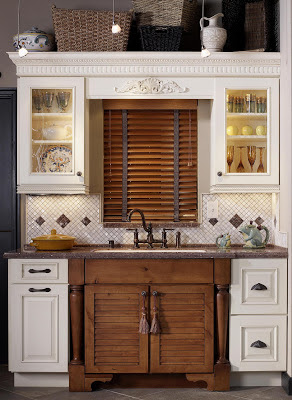I haven't written for
Houzz.com for a year and a half, yet every day I wade through no fewer than five e-mails from Houzz members. To a one, those emails are asking questions that can be answered by clicking on the "more info" link next to a photo I posted, or they're asking unanswerable questions such as "what color is that?" or "what's the name of that granite?"
Again, judging precise color based on an internet photo is impossible, especially if it's in a product photo. Product photos tend to be heavily Photoshopped and actual colors get lost in the mix. Never mind that you're viewing everything on an uncalibrated monitor.
What prompted this post was an e-mail I received a half an hour ago. Here's the question and the photo:
Clicking on the "more info" link would have told this person that what's in that photo is a cork floor from US Floors in Atlanta. Those floors aren't sold retail and are only available from a showroom at around $8 a square foot. I get it that most people don't buy things like new floors every day and that the general population doesn't have the product knowledge that people like I do. But still,
think and be respectful. Houzz's links are clearly identifiable and they're there for a reason.
Aside from that, the colors and patterns you see on the internet aren't real and the only way to select a color for anything is by looking at a sample in real life.
This vignette is from a showroom where I once worked. The cabinetry colors are Oyster Vintage over Maple and Harvest Bronze on Knotty Alder from Medallion Cabintry. The wall color is Sherwin-Williams 7037. The back splash is two colors of mother of pearl. The hardware on the cabinets is from Schaub and the finish is oil-rubbed bronze. The faucet is from Rohl and the counter is
Tusk from Avonite. I know this because I designed this display.
However, this vignette was shot by a professional photographer who flooded the whole showroom with artificial light. In your home, colors such as Oyster Vintage, Harvest Bronze and Sherwin-Williams 7037 will look nothing like they do in this photo. Asking for their names is irrelevant Ask instead for a white-ish paint color, a rich brown color and a strong neutral for the walls, because trust me, the colors shown here look very little like this in real life.
Similarly, natural stone patterns don't have formal names. What's Labrador in your market is Uba Tuba in someone else's. Not only that, those patterns change, often radically, over time. A stone labeled Crema Bordeaux today looks nothing like the same stone from the same quarry in Brazil five years ago.
I get a lot of e-mail from people who describe a room and then tell me about their dilemmas about how to furnish or paint said room. While I appreciate that strangers see me as an authority, I won't answer a question like that out of principle. My training as a designer taught me early that I need to see and be in a room before I can figure out what to do with it.
A designer sees things from a dispassionate, removed perspective and it's a designer's job to a) plan a space, and b) save you money in doing so. If you have a difficult room or if you've hit the wall, hire a designer.
Good design advice is never free in the same way that legal, medical, real estate or tax planning advice is never free. Designers make a living from their expert opinion, the same as any other professional. It's as true in real life as it's true online.
Houzz.com has done amazing things in providing the public with a library of inspirational photos. They've done a great job of designer outreach too. But there's a disconnect in there somewhere. The people who write for that site aren't there to offer free advice. They're there to increase their presence on the internet and they do it for very little money. Please respect that. What you see on the internet isn't real and there's no substitute for a design professional. Hire an independent designer.


































